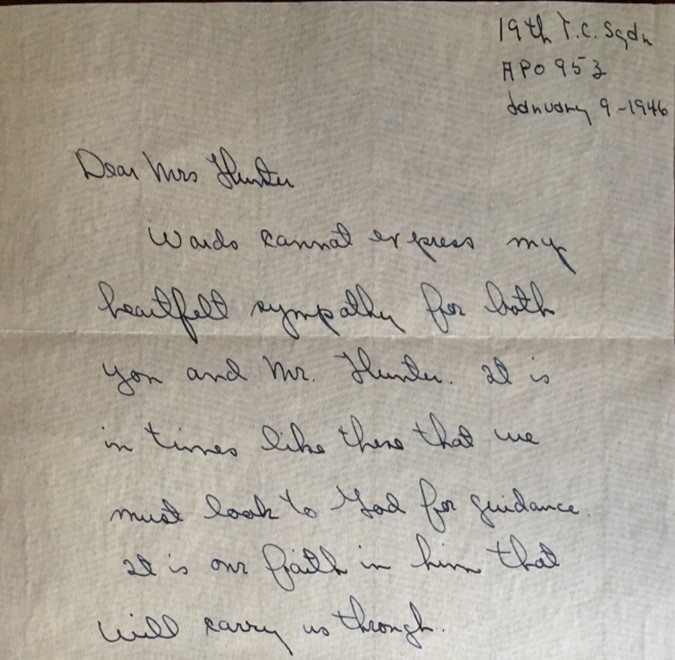EDITOR’S NOTE: There are only a few blogs remaining and we’ll we sharing them soon. We will be sharing entries from Old Tillamook Times, provided by Sandi Burgess Botten Dean, featuring Karen Kranweiss Nudelman’s blog in which she describes the search and book writing that started a little over 10 years ago when she first received “the letters” and began reading. Then came the idea for a story, then a book – “Dear Folks” tells a young man’s story through letters he wrote home to his parents in Tillamook, Oregon. Links to the introduction to the story and the series are below.
by Karen Krantweiss Nudelman
January 9, 1946
Dear Mrs. Hunter,
Words cannot express my heartfelt sympathy for both of you and Mr. Hunter. It is times like these that we must look to God for guidance. It is our faith in him that will carry us through…
I remember exactly where I was and what I was doing when I read those words from the last letter in the stack. I had just finished sharing some of Chuck’s stories with my husband. I was exhilarated about the treasure trove of information that this personal account of WWII had offered me. I was looking forward to doing research on this young man, “Chuck Hunter” and see if he married Sherry or found his way back to his high school love, Joyce. Of course, my ultimate joy would be to find his children or grandchildren and give them back the letters that somehow escaped their rightful possession.
I was standing in my kitchen, too excited to sit down as I reached for the last letter dated 1946. And there it was. Devastating news in the first few words. I think I made it to “heartfelt sympathy” before I cried out to my husband.
Oh God no. Please. No.
This whole time I spent absorbed in Chuck’s world, it never occurred to me, not once, that he wouldn’t make it back home. He was so animated. I swore at times, I could hear his youthful voice deepening to that of a man as time went on. I was shaken to my core. I wanted to grieve for someone who died 70 years ago. A stranger who had become important to me. I checked the letter’s date against the last letter written by Chuck. Somewhere between August 1945 and January 1946, Chuck lost his life. But how. And where? The war was over. What the hell happened?
I turned on my computer and did a search for both his name and his sister, Helen Hunter. Immediately, an obituary from the Tillamook Headlight Herald appeared. It was Helen’s.
Helen Beth Hunter was born in Tillamook Nov. 13, 1920, and died Oct. 16, 2008, in Wheeler at age 87.
Her parents were Alice Todd Hunter and Frank William Hunter. They lived on McCormick Loop on a few acres, and one of her joys, when young, was horseback riding with her dog. She was devoted to animals her entire life. Helen was quite athletic, was an avid skier, and loved hiking and walking.
Her brother, Charles, was born in 1924, and they both attended Hunt Grade School and graduated from Tillamook High School. Both were baptized in the First Christian Church in Tillamook, where Helen has been a member since she was 9.
After high school, Helen enrolled in Linfield College and graduated with a Bachelor of Science degree in 1942. She then enrolled in Yale University’s School of Nursing, receiving her master’s degree in nursing and R.N. in 1945.
Helen’s brother, Charles, joined the Air Corps, where he was a radio operator during the war. He was killed in September 1945, when his plane crashed into a mountain in Japan while trying to bring out some prisoners of war.
Helen decided to join the Army Nurse Corps in 1945 as a 2nd Lieutenant, and spent 20 years in the Army, retiring as a major in 1965. She was stationed in various posts in the United States and abroad, as she loved to travel.
After retiring from the military, she returned to Tillamook County and bought a home overlooking the beach near Neah-Kah-Nie Mountain. During this time, she worked as director of nurses for the Rinehart Hospital in Wheeler.
After the death of her father in 1969, she cared for her mother, who still lived in Tillamook. Helen was then able to be at her home in Neah-Kah-Nie again full-time with her beloved cats.
She had a lively intellect, a kind heart, and a sense of humor. Into her later life, Helen continued to travel the world, touring each continent – even Antarctica – and telling stories of her adventures. When with her relatives at holidays, they loved to see what stories she had to tell while looking at her wonderful photographs – of penguins, Komodo dragons, and the Panama Canal.
There was no mention of a husband or children. But what an exceptional life she had lived. Served our country, cared for her parents and travelled the world. As I read the excerpt about her brother Chuck’s death in September 1945, one thought passed through my mind. There are no descendants of their family. There was most likely no one alive to remember Chuck. He had no wife or children. He had 21 years on this earth. He left this world tragically, without a legacy. I was now the custodian of his story. Seventy years after his death, this responsibility had fallen to me, a total stranger. And I accepted the task without hesitation.
The obituary had mentioned an Army Air Corps mission with the purpose of saving Prisoners of War. A phone call to the Tillamook County Pioneer Museum confirmed these details and the date of his death: September 22, 1945. Better still, the museum staff pulled records from storage about the Hunter family – including Chuck’s obituary and letters from the War Department.
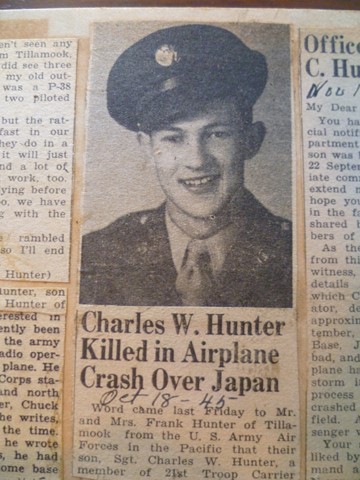
The museum documents included the following information about his death: During September 1945 Charles and the 374th Squadron were flying equipment and provisions to prison camps and returning prisoners to stations under American supervision. Charles’ plane crashed into a mountain outside Yamato, Japan.
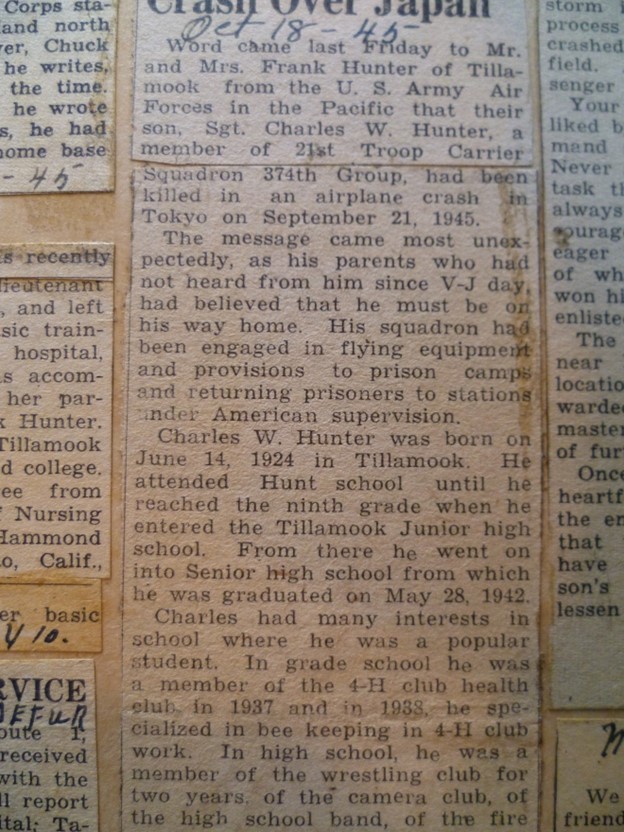
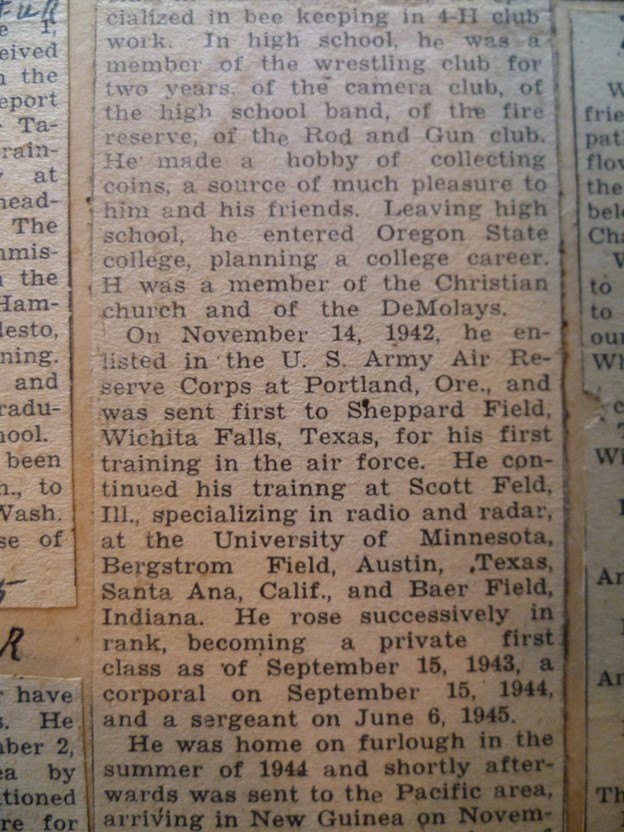
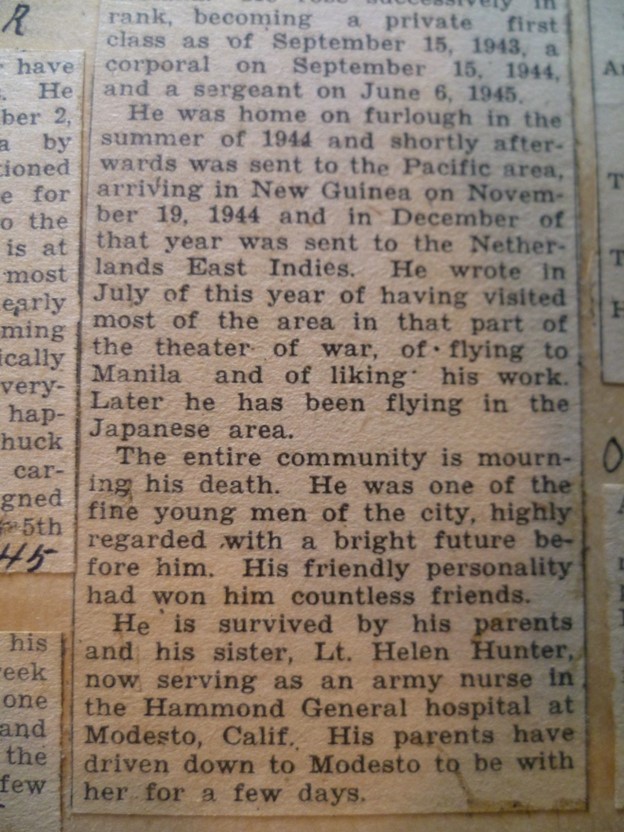
He was a hero. The day he died, he saved the lives of his brothers who were prisoners of war. I had to know more. I needed to know…how many people did he save that day? What POW camps received supplies and food from his plane? My next step was historical research on the early days of the Occupation of Japan.
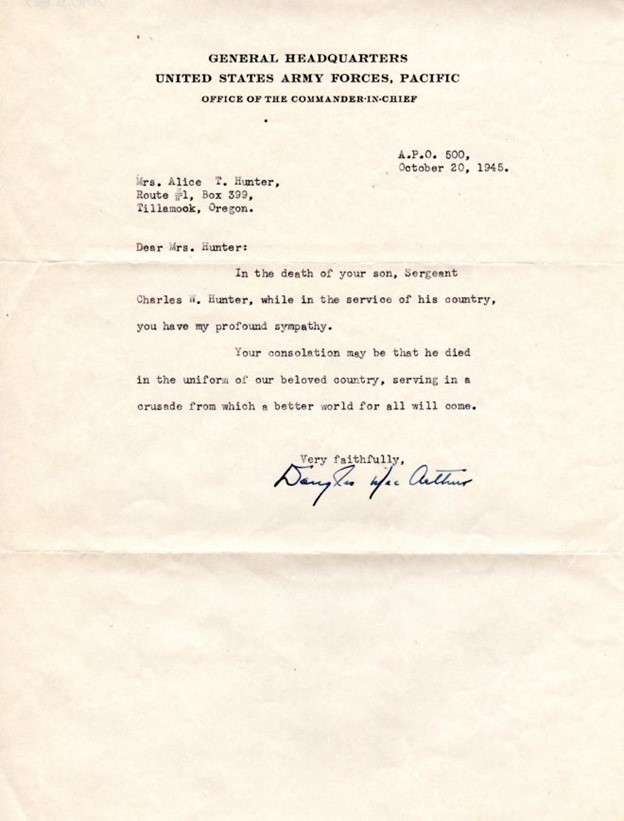
I poured over the reports of General MacArthur, available online through the Library of Congress. I never knew about the brave and very dangerous effort led by the 20th Air Force to drop supplies to thousands of dying men. They dropped steel drums filled to the brim with food and medical items, each one floated down swiftly with the aid of a cargo parachute. Just one month before, these planes were releasing bombs at a safe distance away from the explosion. But in order for the drums to land safely, the drops needed to be at 1,000 feet.
Seventy-seven rescuers died during “Operation Swift Mercy” which was initiated on August 30 and ended on September 20, 1945. I found the names of the 77 men on a casualty list, but Charles W. Hunter was not mentioned among them. And if POW rescue mission ended on September 20th, why was Chuck’s death date recorded as September 22nd?
To be continued…
Here are links to the previous stories about Karen’s journey to document Chuck Hunter’s life:

